If you love flaky pastry and have missed the buttery layers of this French treat since going gluten-free, this gluten-free pastry recipe is for you. It bakes up crisp, golden, and full of delicate layers, perfect for making everything from danishes to turnovers, and all things flaky!
This post may contain affiliate links. Please read our Disclosure Policy.
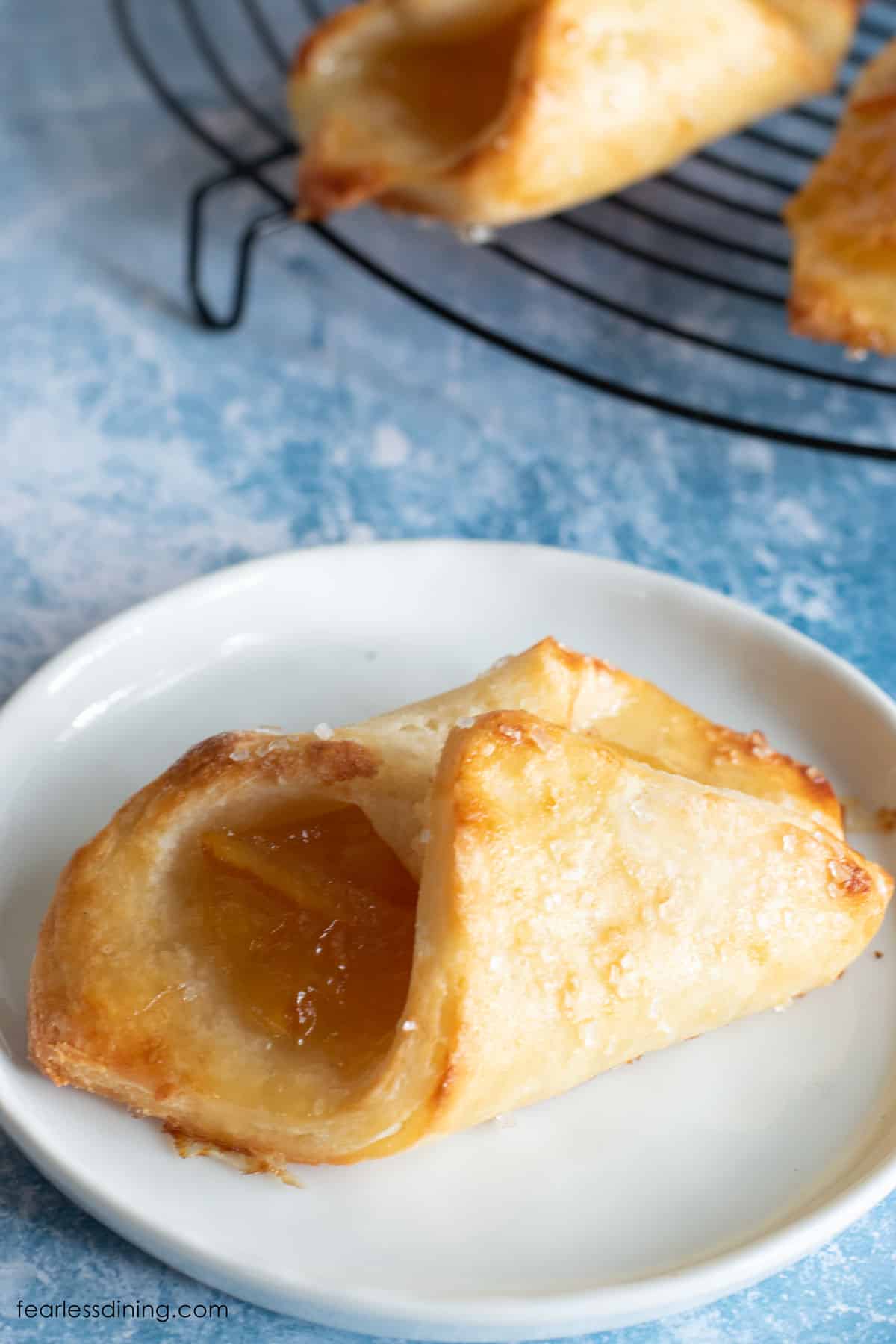
❤️ Why this gluten-free pastry recipe is great:
These three words don’t seem to go together at all. Flaky. Pastries. Gluten-free. This baking project seemed complex and scary, but in all honesty, the hardest part of this recipe is patience.
This is not a recipe for those in a hurry, but I do promise it is easy to make. Making this pastry dough involves several repeat steps to achieve the flakiness in the dough. These homemade pastries are made with my gluten-free rough puff pastry dough. It is easier than yeasted versions, and has the same delicious results.
I assure you that making gluten-free pastry is easy, and the results are worth all of the steps. These pastries are perfect for dessert or anytime of day! If you love French desserts, here are two more delicious gluten free recipes to make your mouth water: Fool-Proof Gluten Free Apple Cake and Gluten Free French Apple Cakes.
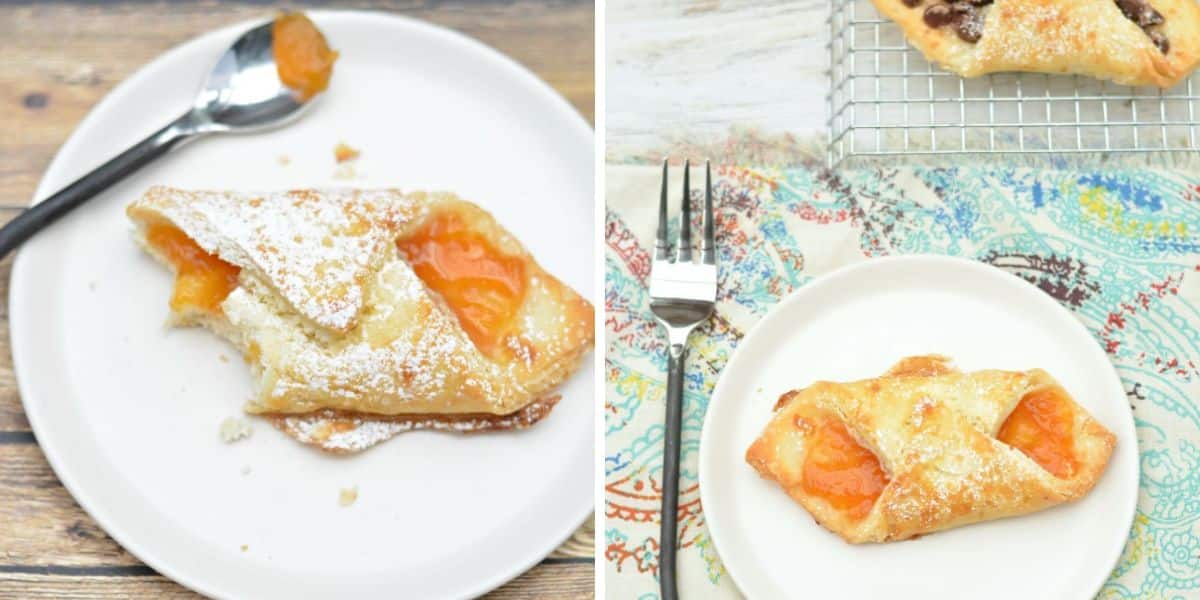
Trust me; it is worth it. If you LOVE this gluten-free pastry recipe, wait until you try my Gluten-Free Cheese Danish recipe!!
Ingredients Notes:
For the full list of ingredients and amounts, please go to the recipe card below.
- Gluten-Free Flour Blend – I tested this recipe with King Arthur Measure for Measure, Cup4Cup, and my Gluten-Free Pastry Flour Blend.
- Cane Sugar – Sugar adds a touch of sweetness and helps the gluten-free pastry brown more evenly during baking. It also adds a little caramelization and gives the crust a delicate golden color.
- Salt – I used sea salt, and it helps to balance the sweetness of the dough.
- Unsalted Butter – Using butter is the key to puff pastry’s flakiness. I recommend using high-fat European-style butter (82 to 85% butterfat) because it helps to create steam during baking. This steam separates the dough into crisp layers.
- Egg – Use a small egg since this is for the egg wash. An egg wash helps the pastry develop a shiny, golden color and also acts as a glue to seal edges or help toppings stick.
- Cold Water – I recommend using purified water so that the chlorine or other chemicals in the water will not add an off-taste. Water must be very cold to help prevent the butter from melting.
Make the pastries dairy-free using my Gluten-Free Dairy-Free Rough Puff Pastry Dough. You may also love this Gluten-Free Apple Turnover recipe.
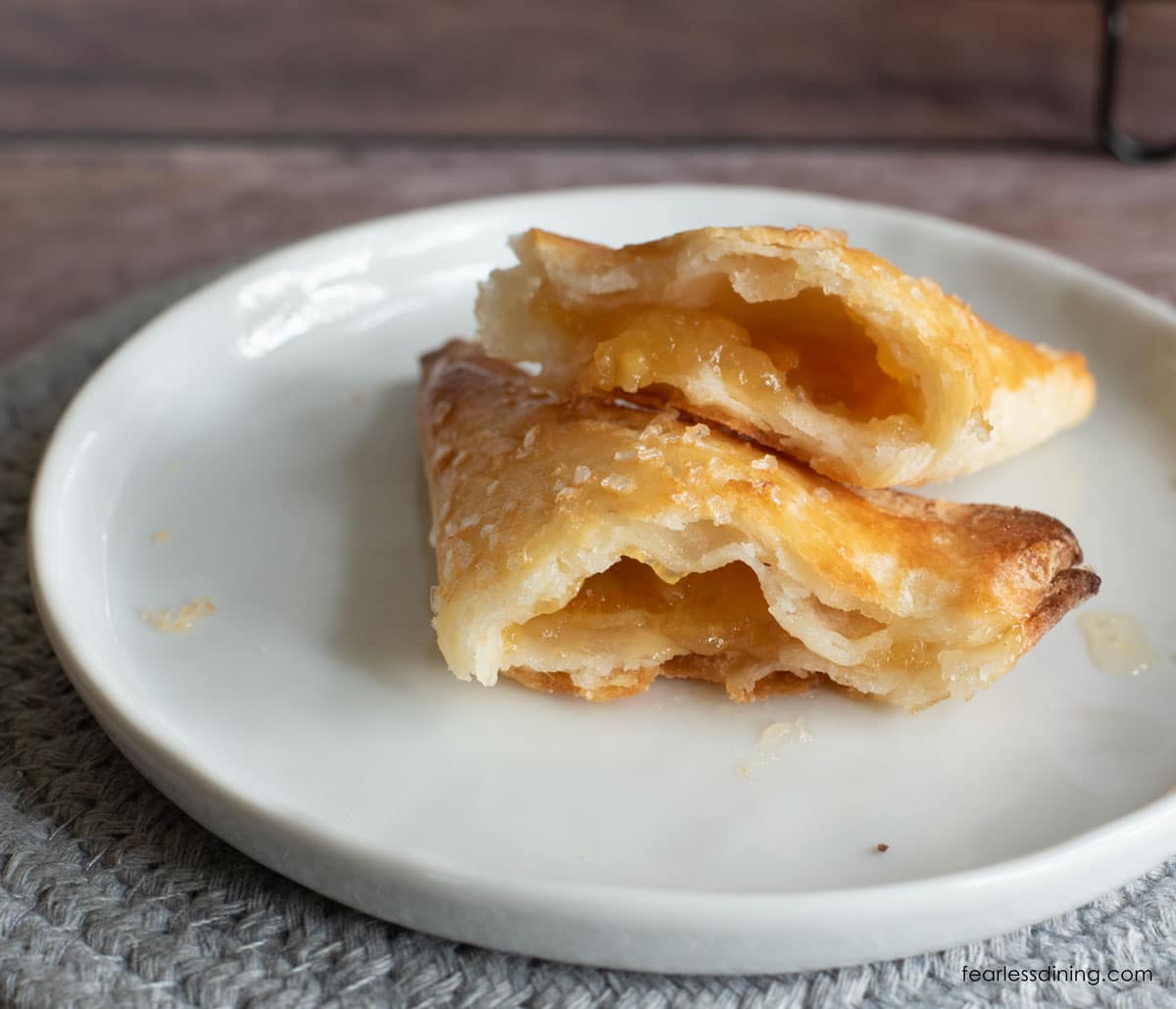
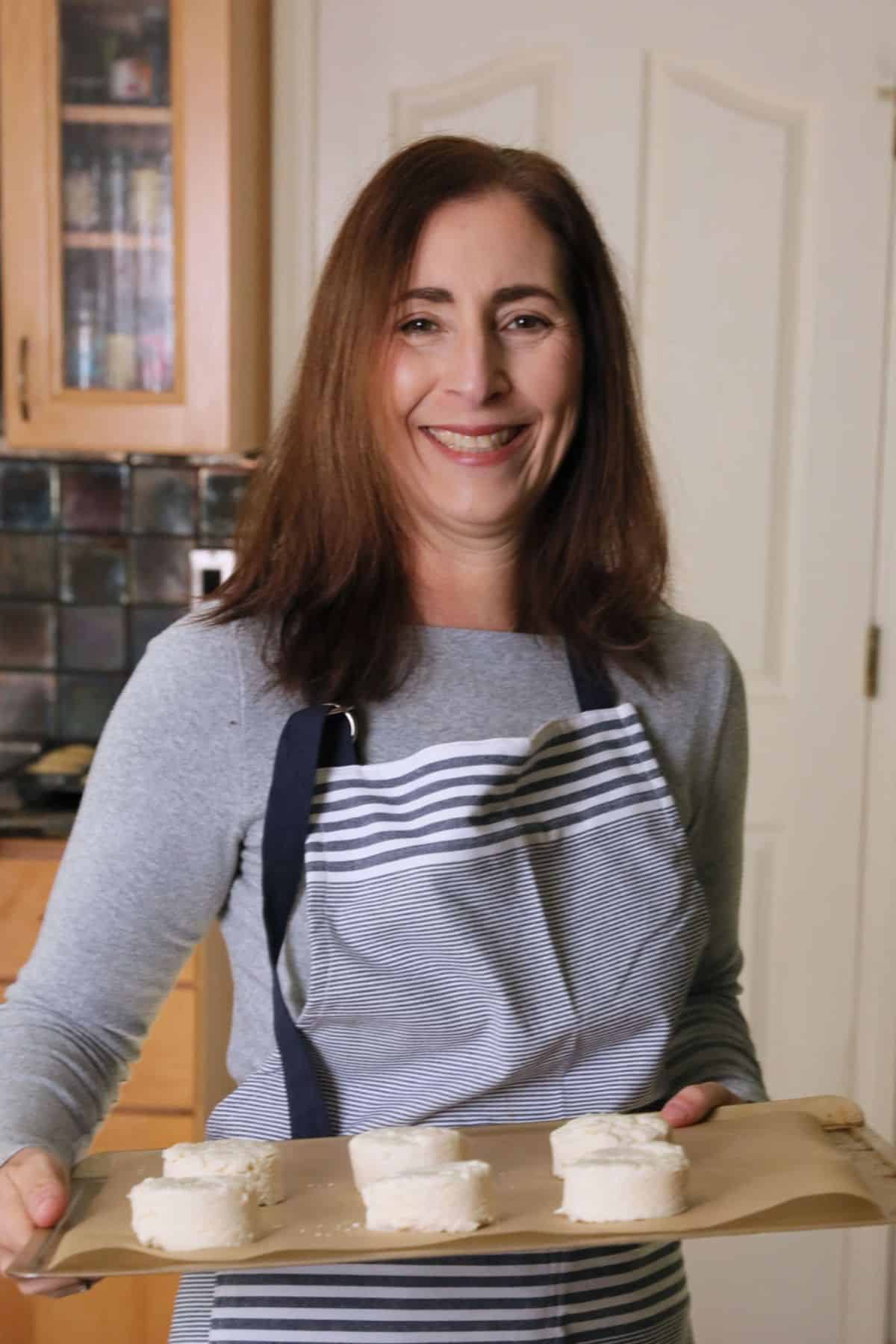
A Note From My Kitchen
If gluten-free pastry makes you feel intimidated, you are not alone. I have been there too. But don’t worry, because this recipe is different. I share lots of photos to show you every step. I created this pastry recipe with care and tested it many times to make sure it’s easy to work with and bakes up tender and flaky. You will find tips throughout the post to guide you, including how to adjust the dough if it is too dry or sticky.
Remember, gluten-free dough feels different than traditional pastry, but with a little practice (and patience!), you will be shaping beautiful pastries in no time.
How To Make Gluten Free Pastry:
Are you ready to see how to make this gluten free flaky pastry dough step by step? Grab a rolling pin; you will need it to laminate the pastry dough. This is what makes all of the buttery layers! For more details, you can always refer back to my gluten-free rough puff pastry recipe.
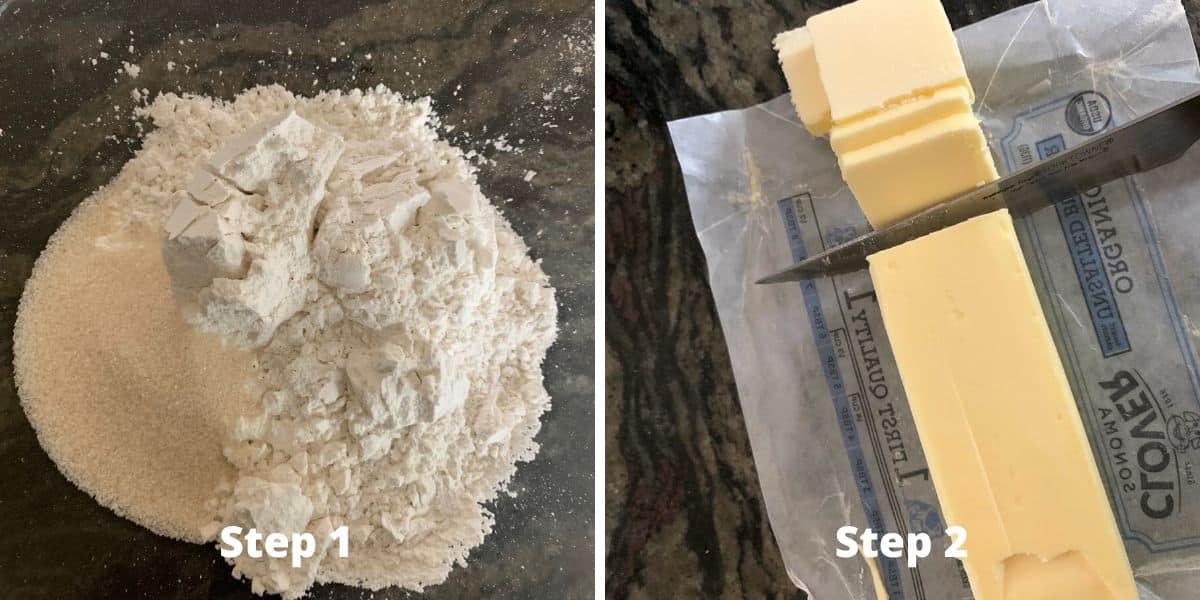
Step 1: Add the flour, sugar, and salt to a bowl and use a whisk to blend.
Step 2: Chop the stick of cold butter into chunks. The colder the butter, the better, so try not to touch the butter with your fingers.
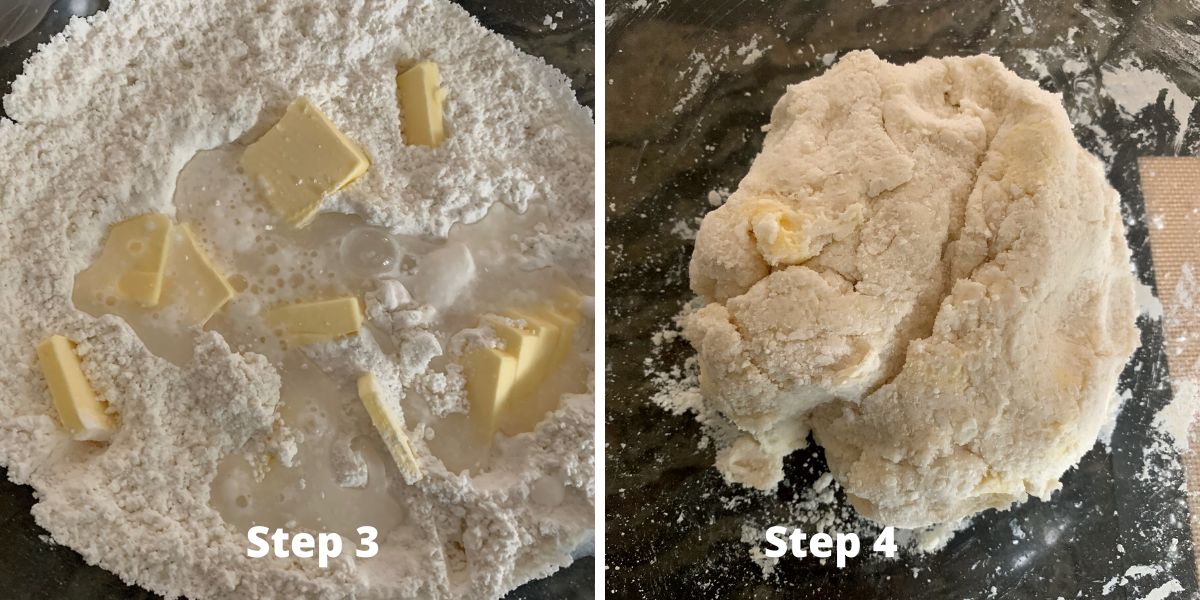
Step 3: Slowly pour the cold water into the dry ingredients and add the cold butter chunks. Mix with a fork or your hands quickly until your mixture forms a dough.
Step 4: You should end up with shaggy pastry dough as shown above. Seeing the large butter chunks in the dough is good!
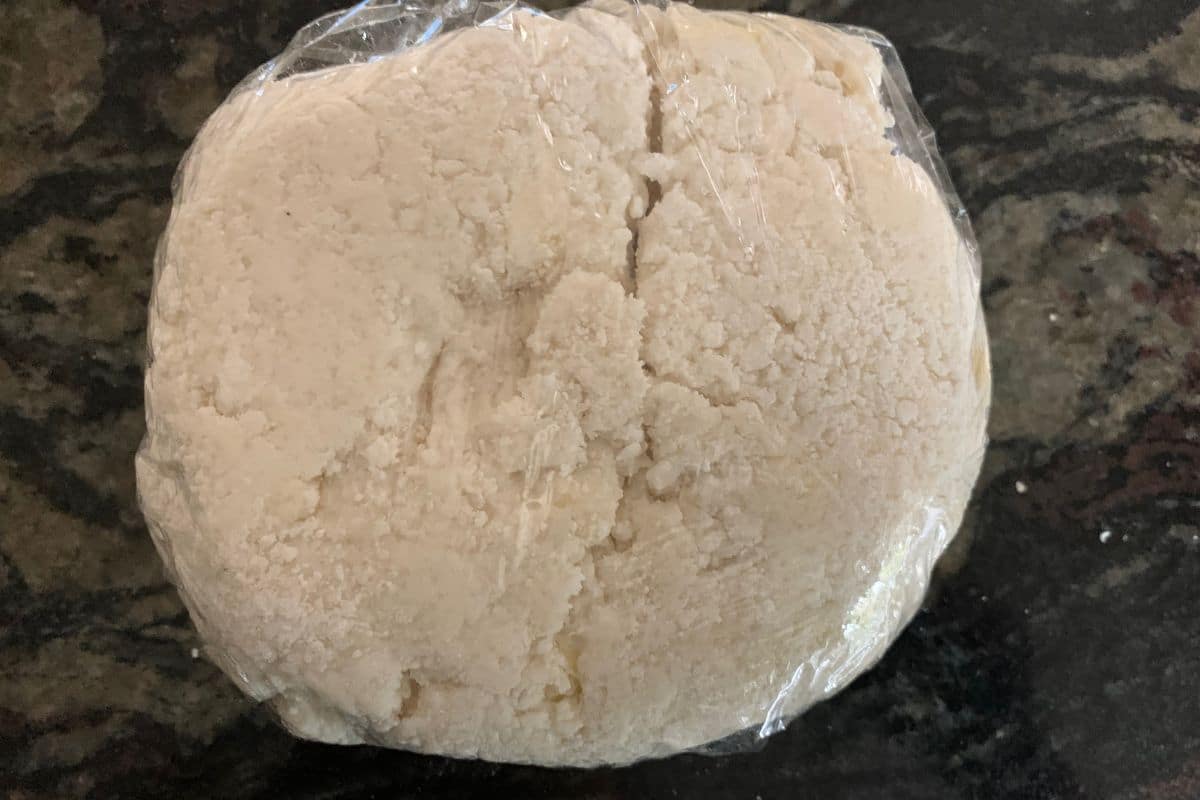
Step 5: Now comes all of the chilling and rolling steps. This is an easy process, but it is time-consuming. Wrap the dough in plastic wrap and pop it into the refrigerator for 30-45 (or more) minutes.
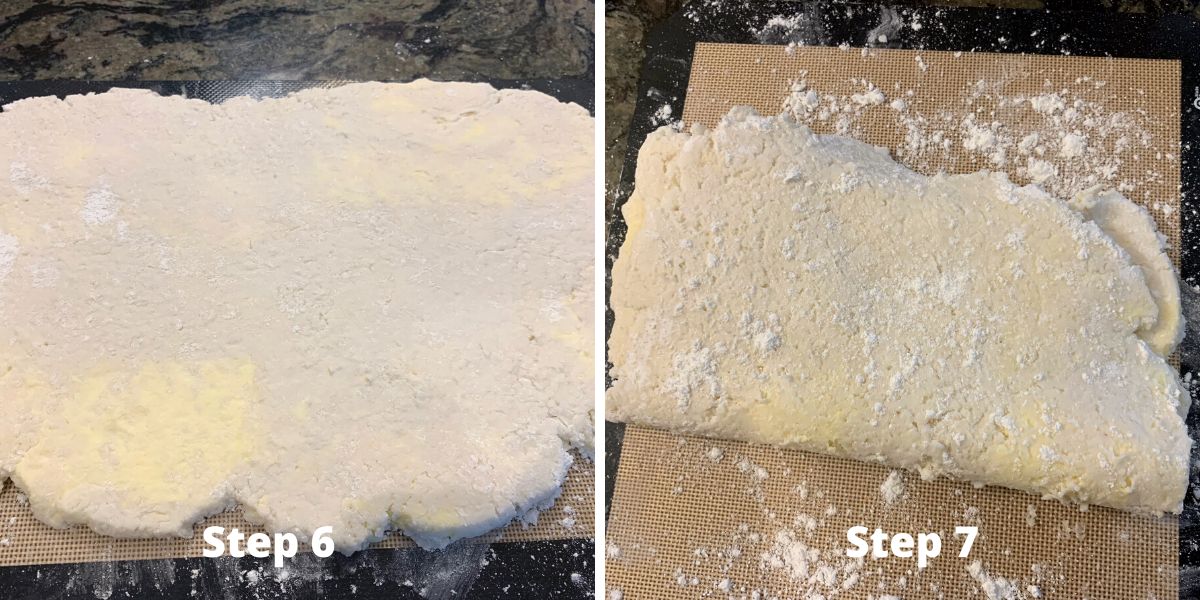
Email This Recipe To Me!
Step 6: Now it is time to laminate your gluten free puff pastry dough. This process is how those big chunks of butter work into the dough in thinner pieces. This is the magic behind creating those flaky layers.
Place the dough onto a gf flour-dusted surface. Also, dust the top of the dough. Roll the dough in one direction to make a long rectangle. If the dough gets soft spots, stop and chill the dough longer.
Step 7: Fold one side of the dough up past the middle, as I show in the photo above, in what is called a two-letter fold. Then, fold the other end over the first fold. The key is to cover the butter and nestle the dough around it.
We are going to repeat this process a lot. Each layer breaks up the butter into thin bits mixed into the dough. Think of the thin areas of butter creating pockets of flaky layers.
Step 8: Do the envelope fold again. Wrap the gluten free dough in plastic wrap and refrigerate for another 30-45 minutes.
👀 Sandi Says: Remove the dough from the refrigerator and repeat steps 6 and 7. Repeat the refrigeration. Repeat the rolling, folding, and refrigerating 5-6 more times.
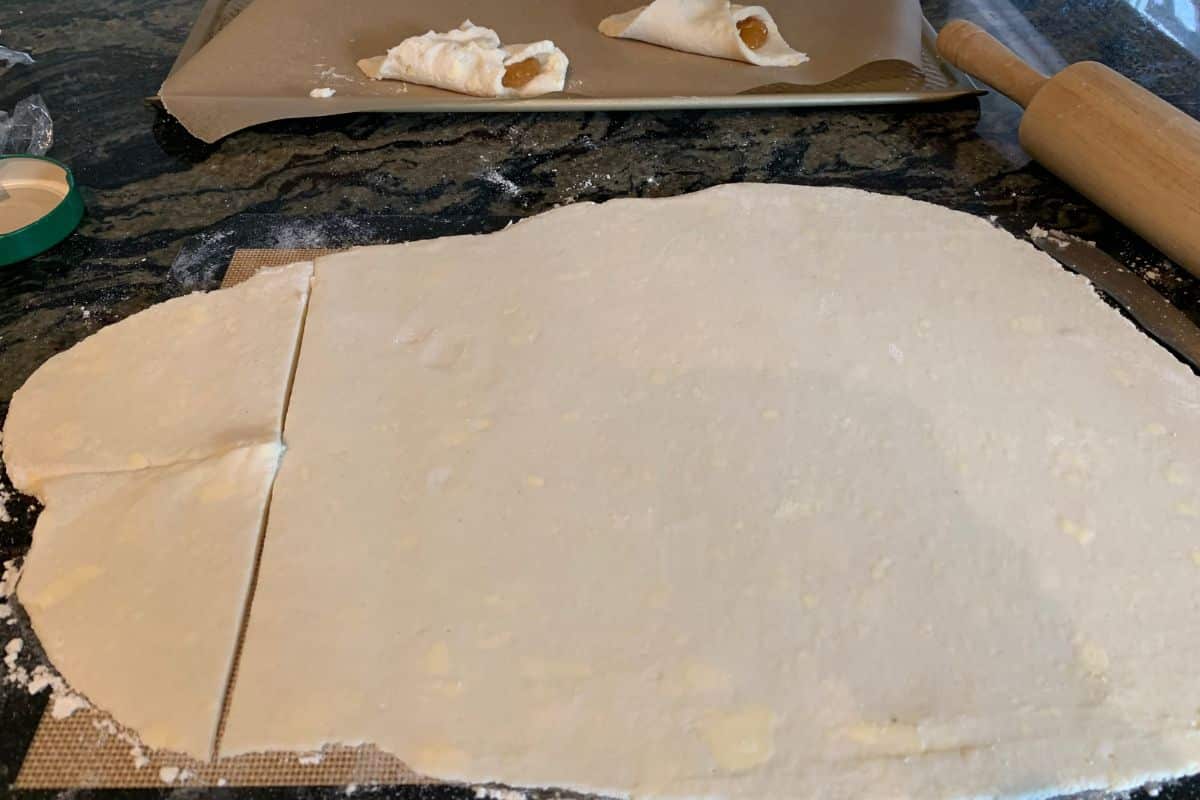
Step 9: Dust the silicone mat or surface with flour and roll your pastry dough to 1/4 inch thickness. Use a sharp knife to cut the dough into rectangles. (Do not roll it any thinner or the dough will be too thin to make flaky layers.)
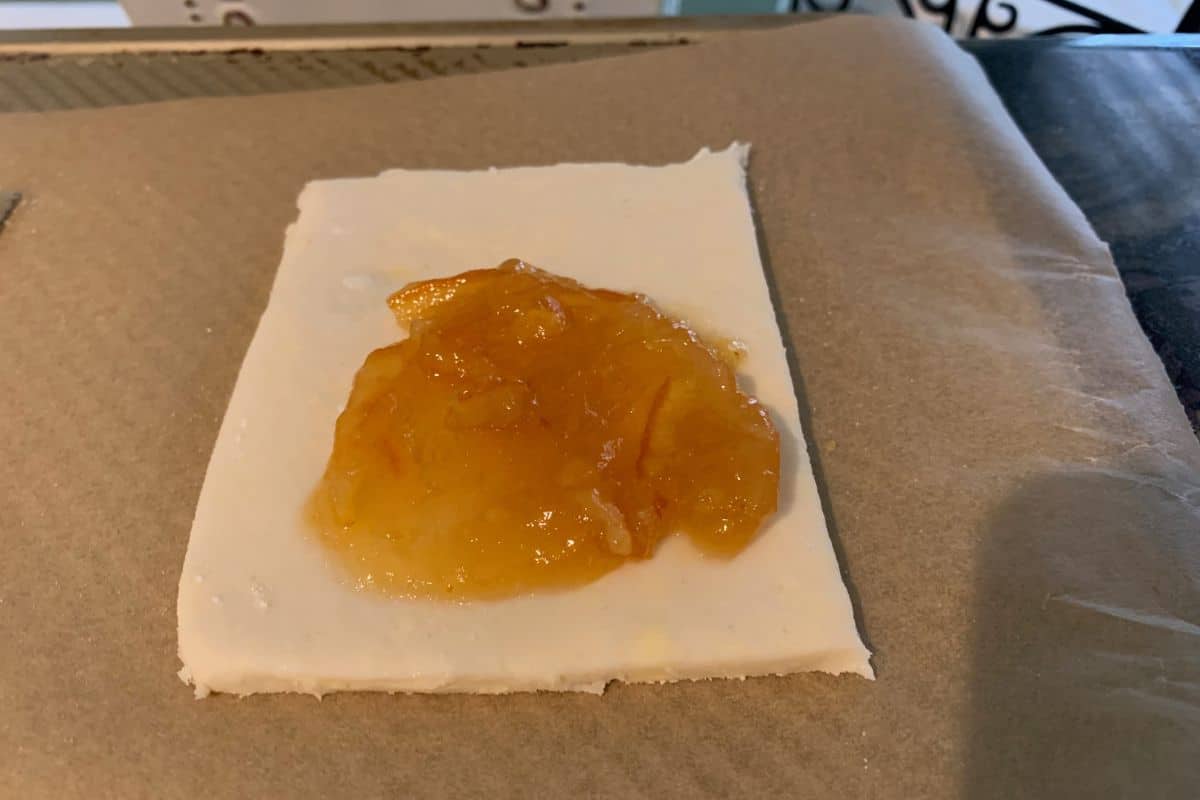
Step 10: Cut the dough into the desired shape and add the filling. This one has orange marmalade. You can use any jam, fresh fruit, pie filling, or chocolate!
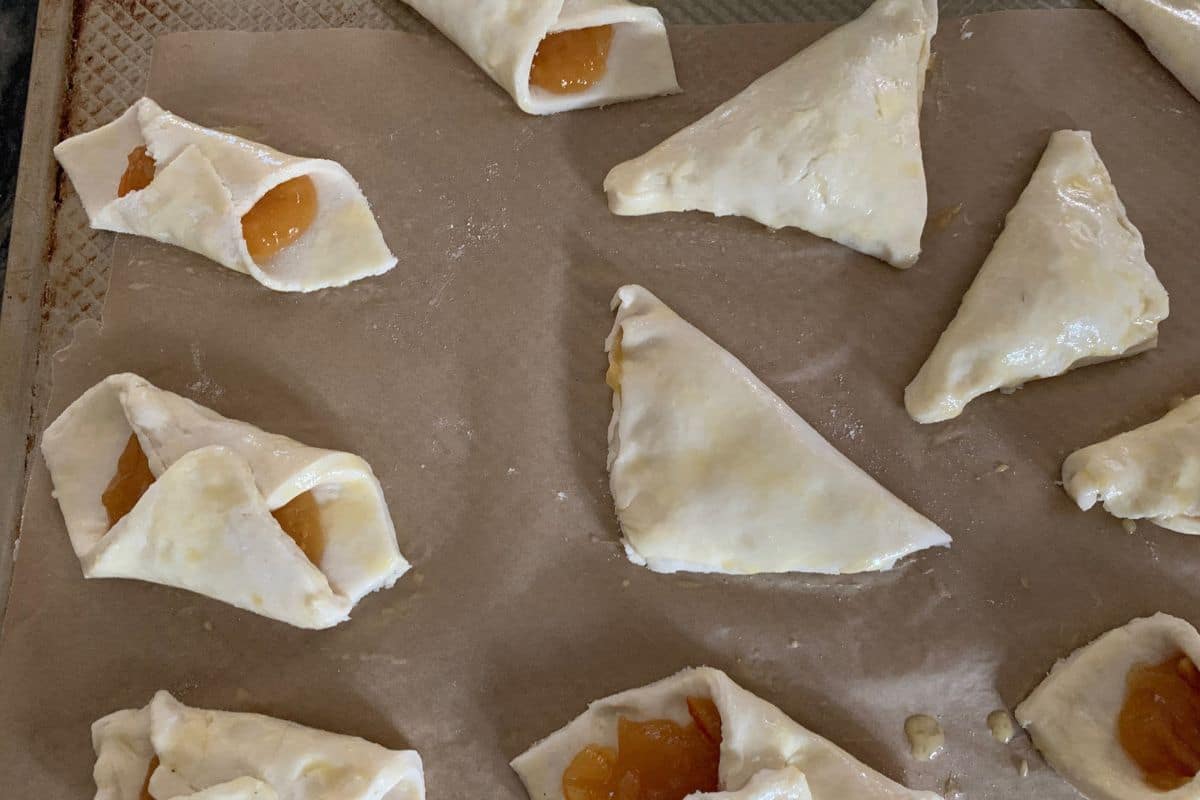
Step 11: Roll or fold the dough over the filling. Here are two folds I did with my pastry. Next, brush each with an egg wash. Preheat the oven to 425º F.
Step 12: Place the pastries in the freezer while the oven preheats. You want the oven temperature to be hot so the butter quickly steams and makes the flaky layers. Bake for 15-20 minutes. The baking time will vary by the size of the pastries you make. After this time, if they need more baking, turn the oven temperature down to 375º F. You want the pastries to be very golden when they are finished baking.
What To Do With Dough Scraps:
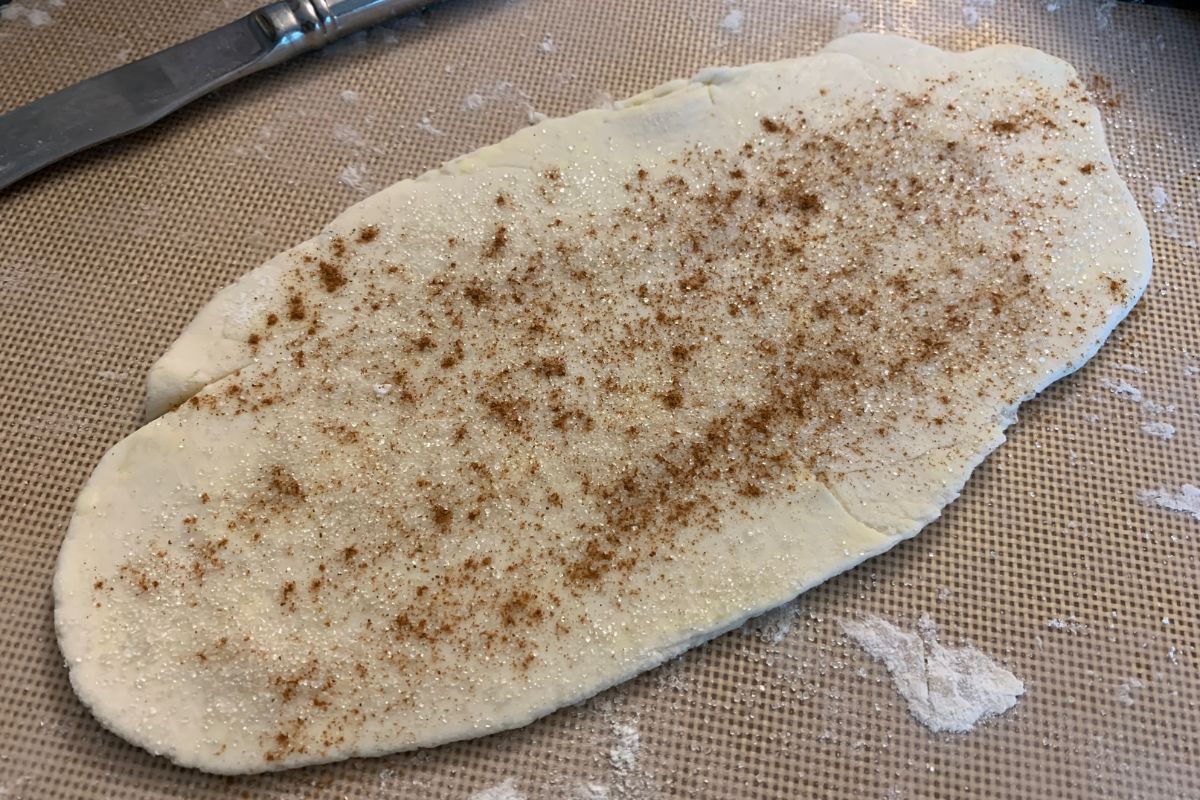
I always end up having bits of dough left over after straightening edges. Roll the scraps flat and then sprinkle sugar and cinnamon over this dough.
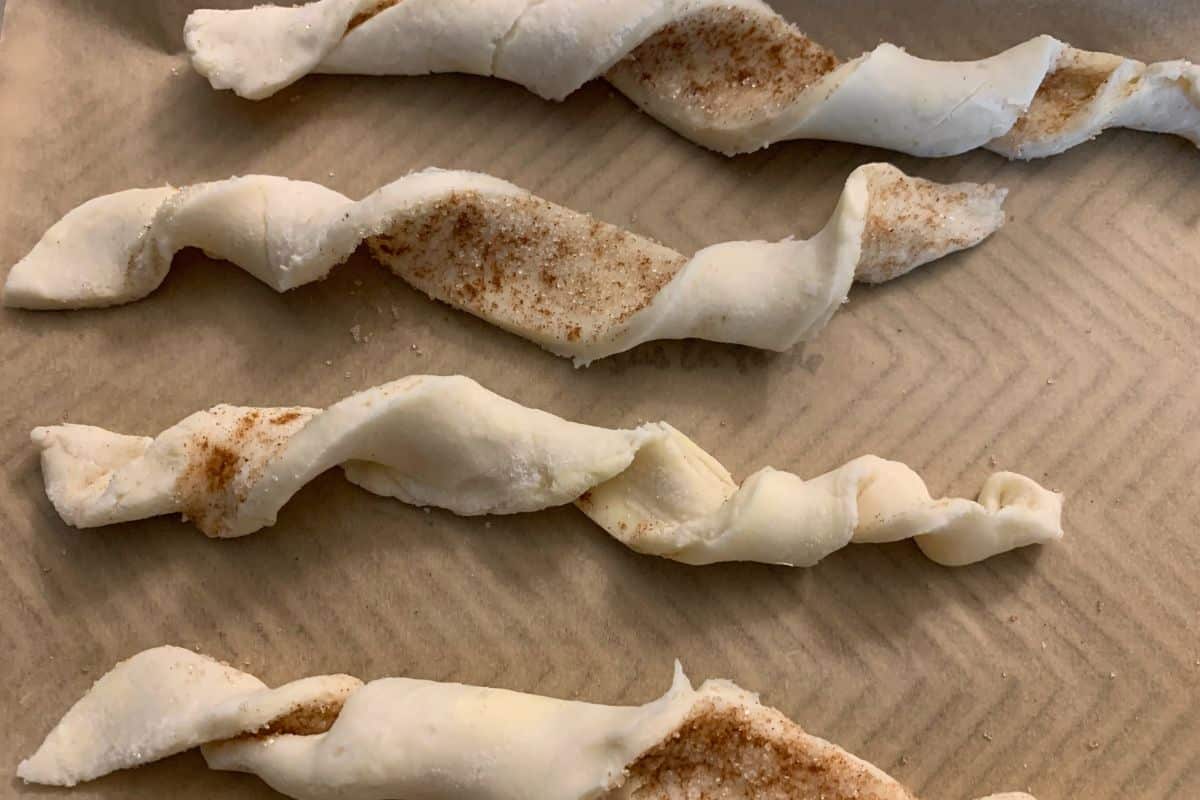
Don’t waste the dough scraps! You can make these cinnamon twists with them!
- Cut the dough into strips and twist them.
- Sprinkle the strips with cinnamon and sugar.
- Bake for 12-15 minutes, depending on the size of your pastries.
- Remove from the oven and allow them to cool.
Tips For Success
1. Freeze the butter. It makes things so much better when your butter is cold!
2. Use ice water without the ice cubes. Your mantra for this easy gluten free rough pastry recipe is cold. Cold butter is what makes those flaky layers!
3. Do not be afraid to dust the mat and dough liberally with gf flour.
4. Refrigerate your dough between every step when you laminate your gluten free puff pastry dough!
Pastry Fillings Ideas:
- Jam (I like jam better than jelly because jam has fruit pieces in it.) If you love jam in pastries, try my Gluten Free Kolache recipe!
- Nutella
- Chocolate chunks
- Cream cheese
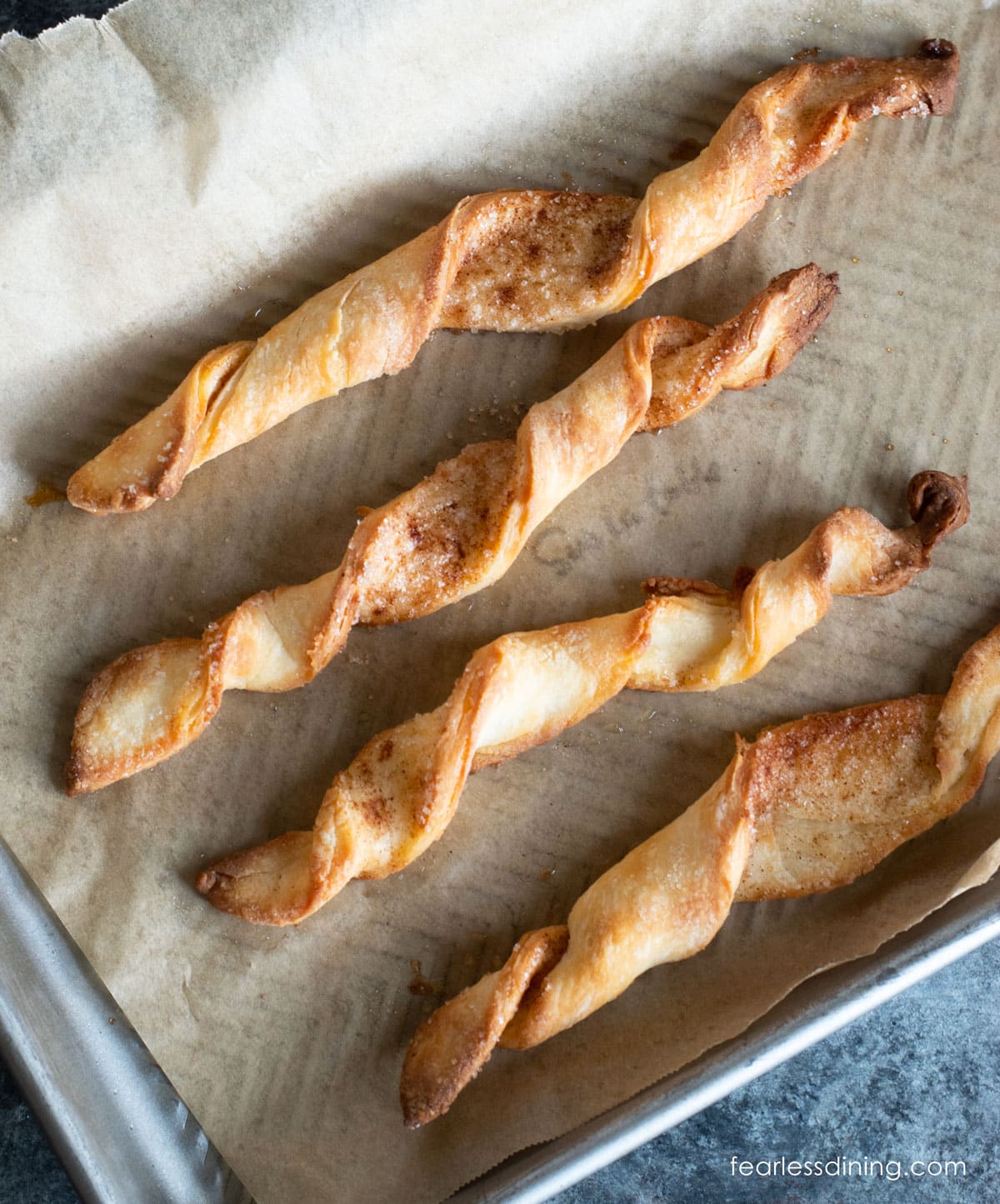
Frequently Asked Questions:
These pastries will keep fresh for up to 4 days in an air-tight container or up to 4 months in the freezer.
Yes! After the lamination dough process, wrap the dough in plastic wrap, then place that into a freezer bag. Thaw the dough and shape your pastries when you are ready to use the dough.
Feel free to contact me via my contact page, and I will send it to you. I decided that although the older version of my recipe with active dry yeast is really good, gluten free dough only gets one good rise. Because this recipe needs a LOT of rolling and chilling, the yeast served no purpose.
More recipes using this gluten free rough puff dough:
- Gluten-Free Turnovers
- Gluten-Free Cheese Danish
- Make a Gluten-Free Rough Puff Pie Crust for extra flakiness.
Love This Recipe?
💬 Did you make this recipe? Drop a comment below, and let me know how it turned out! ⭐⭐⭐⭐⭐ Please include which flour blend you used. This will help others know this recipe is delicious. Thank you!
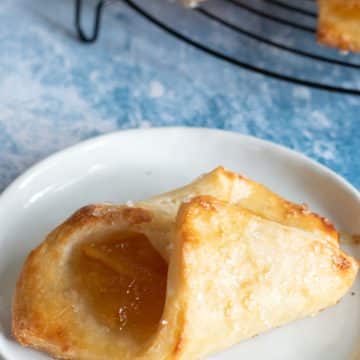
Gluten-Free Pastries (Flaky and Delicious!)
Equipment
Ingredients
- 2 ½ cup gluten free flour blend * see note!
- ¼ cup cane sugar
- ⅛ teaspoon salt
- 3/4-1 cup cold water Use purified water.
- ½ cup unsalted COLD butter COLD
Filling:
- 1 small egg for the egg wash
- Use any filling you like, including jam, Nutella, etc.
Email This Recipe To Me!
Instructions
- Add 2 1/2 cup gluten free flour blend, 1/4 cup cane sugar, and 1/8 teaspoon salt to a large mixing bowl and whisk to blend.
- Pour 3/4-1 cup cold water into the dry ingredients, mix, and then add the cold 1/2 cup unsalted COLD butter chunks. Mix with a fork or your hands until your mixture forms a dough with big butter lumps.
- Wrap the dough in plastic wrap and pop it into the refrigerator for 30-45 minutes. You need the dough cold to laminate it. If it is too cold, let it sit on the counter for a few minutes until it softens a little.
- Now it is time to laminate your gluten free puff pastry dough. This a rolling and folding process that rolls the big chunks of butter into the dough in thinner pieces.
- Place the dough onto a gluten-free flour-dusted silicone mat. Roll the dough to 1/4 inch thickness in one direction. Fold one side of the dough up past the middle, as I show in the photo above, in what is called an envelope fold. Then, fold the other end over the first fold.
- The key is to cover the butter and nestle the dough around it. It is good to see butter streaks in the dough! If the dough gets soft spots, stop immediately, fold it, wrap it in plastic, and chill it more. Dust the silicone mat and the top of the dough every time you roll it to prevent sticking.
- We are going to repeat this process six more times. Each layer breaks up the butter into thin layers in the dough. The thin areas of butter create pockets of flaky layers.
- Fold the dough in the envelope fold again. Wrap it in plastic wrap and refrigerate for 30-45 minutes.
- After laminating your dough six times, remove the dough from the refrigerator.
- Dust the silicone mat or surface with flour and roll out the pastry dough to 1/4-inch thickness. Cut the dough into rectangles using a sharp knife. Do not drag the knife or move it back and forth. Doing this can seal the edges, preventing the flakiness.
- Cut the dough into the desired shape and add the filling. This one has orange marmalade. You can use any jam, fresh fruit, pie filling, or chocolate!
- Preheat the oven to 425º F and place the pastries in the freezer for 15 minutes.
- Remove the pastries and brush each one with egg wash. Depending on their size, bake the pastries for 15-20 minutes. When they are finished baking, they will be slightly golden. If you need to bake them longer, turn the oven temperature down to 375º F to prevent burning.
- Remove the pastries from the oven and place them on a cooling rack. Please don't eat them hot because the filling can burn your mouth.
Notes
- I have tested this recipe with the old version of Cup4Cup, King Arthur Measure for Measure, and my new Gluten-Free Pastry Flour Blend. Most blends should work, but do not use whole-grain or heavy-grain flour blends because they won’t get as flaky. My blend turned out the best.
- If your gluten free flour blend does not contain xanthan gum or guar gum, please add 1/2 teaspoon.
- These pastries will keep fresh for up to 4 days in an airtight container or for up to 4 months in the freezer.
- You can freeze the fully laminated dough (after the final fold.) wrapped tightly in plastic wrap and stored in a freezer bag for up to 2 months. Thaw it overnight in the fridge before using it. Let the dough sit at room temperature on the counter to thaw.
SPECIAL NOTE
Please know that every gluten free flour blend has a different starch to grain ratio. If you use a blend I didn’t test, my rule of thumb is to add more flour if your dough or batter is wet and add more liquid if the dough or batter is too dry!
Nutrition
Nutrition Disclaimer
Nutritional information is an estimate provided to you as a courtesy. You should calculate the actual nutritional information with the products and brands you are using with your preferred nutritional calculator.
*This post was updated with more detailed recipe directions from my old 2/23/15 post. If you want the older version of my recipe using yeast, please reach out, and I can send it to you.
I truly hope you enjoy this recipe. I have been testing and creating gluten-free recipes for over 15 years. Creating gluten-free recipes that do not taste gluten-free is my goal for every recipe. Sometimes I only have to test a new recipe a couple of times, and others it takes multiple times. I do this so you get reliable, delicious results every time!


Hello, I just made these with bobs red mill 1 to 1 gluten free baking flour and Nutella. My boys loved them! While baking the butter filled the bottom of the tray and steamed up the oven but they were golden baking for 20 minutes. I made 20 pastries. I tried smuckers simply fruit jam in two of them and the jam kinda ran in the tray. It’s a little work but a lovely treat. Thank you!
Hi Jennifer, I am so glad you all loved the recipe. I would say if the butter ran out like that, you need to chill the dough a lot longer. The little butter pockets created with the rolling and folding are what makes the steam pockets in the dough itself, making the flaky layers.
Hi, can you clarify the recipe please? Do you add all butter and flour that you listed and start kneading and then add more when laminating or you add or you listed a total quantity of butter? If it’s a total quantity then do how much you leave for laminating? Thanks
Hi Kate, There is no kneading in this recipe. If you look at the photos in the recipe post, I show a photo of every step to make this recipe. You use all of the butter, then fold and roll it in multiple times.
Best gluten free pastry I have found yet. I used Bobs Red Mill 1 to 1 baking flour. I used double the water in the recipe to get the mix to become dough. It’s the first one I’ve found that you can actually roll out. My daughter will be ecstatic to have butter tarts for Xmas! Thank you!
Thank you so much for coming back, Debora. I am so glad you loved this recipe. Merry Christmas!
I enjoyed the 2015 version. I actually lost the recipe and lo and behold I found it while going through my stash. is this recipe as delicious and why did you update it????
I’ll assume it’s better. I’m happy I can enjoy these pastries again. I filled mine with apricot and peach preserves. thanks for the yummy-ness
Hi Sandy, I updated it to make it easier for readers who struggle with yeast recipes. I plan to remake this recipe soon and retest it because the flour blend I like Cup4Cup, reformulated and I want to remake it to see if this blend still works.
Hi, this looks great! I have one question though, do you put any butter between the folds when you roll it, it di you add all the butter in the beginning. Also, do you use an electric mixer to mix in the butter, and do you mix it until it’s all incorporated or just partially! Thanks!!
Hi Alexia, I didn’t use an electric mixer. You can mix in the butter chunks, they get rolled thinly, or you can use the pastry blender to do rough larger chunks then roll it multiple times as shown in the photos.
Can you use dairy free butter for these?
Hi Janet, I haven’t tested this particular recipe with dairy-free butter. If you try it, please let me know how it turns out.
Do you have a recipe for better than Robert Redford pudding squares.
Hi Ada, I haven’t heard of these so I did some research. I am sorry to say that I don’t have a recipe similar.
I would like to make a gf sfloglitelle and was wondering if this would be a recipe that would lend itself to adapt to the layers being rolled thin and rolled.
Hi Patricia, I am not sure if this recipe would hold up to very thin layers. I haven’t tried it.
Hi there, just making sure I didn’t misunderstand your Note #1 regarding the flour blend and yeast. Yeast is not used in this recipe right?
Thanks! Hoping to try this soon.
Hi Sherry, when I made this recipe originally, I used yeast, and it will definitely work out well…but I found it isn’t necessary. I changed it to keep it more simple for readers since the flavors turned out the same.
These are AWESOME! I have made them several times, it is my favorite
dessert to make. (And breakfast item).
I am so glad you love the recipe, Nancy. Thank you so much for coming back to leave a review.
Hi! I’m enjoying your posts adn wanting to start trying these pastries which look deliciously delectable! Just got confused about the yeast as this recipe does not include yeast but in the Notes section you mention yeast. How much yeast should we use? Also, am I interpreting the recipe correctly in that you added all the butter slices at once into the flour mix? I’m used to seeing the process of putting some slices in with each fold process instead of all at once. If you’re beautiful results happen without adding some butter with each fold, then I’m truly amazed! So, do we add the butter slices all at once in the beginning?
Hi Renee, If you look in the FAQ, I talk about this. The recipe used to have yeast, but with all of the rolling, the yeast really don’t affect the recipe so I retested the recipe without yeast. It works just as well and this way those who can’t have yeast can enjoy this recipe.
A G F member was recently added to our family. I often have the family for dinner and want to be sure the food is healthy for them. I have never cooked gluten free so I realy need help
Hi Katy, If you go to the New, Start Here tab in my blog menu, many great articles that will help you. I also recommend my Facebook group, Gluten Free Living and Recipe Share to connect with others and get support.
Hi, do you have anything similar to this, and also yeast free, that is savory and could be used for making spanokopita?
Hi Yael, I do not, but maybe if you omit the sugar this recipe could work?
Hi Sandi, this looks amazing! One of the things I really miss the most having to be gluten free is serious yeasted flakey pastry like croissants etc. I was wondering if this dough could be frozen before shaping or baking, as back in my gluten days I use to be able to get frozen uncooked croissants and filled pastries that you could take out of the freezer, let thaw/rise for an hour or so, then bake fresh, and it was so nice to just have one or two pastries hot out of the oven for breakfast on a weekend. Either that or having the dough ready to make into whatever flavor/shape you want, without having to make the dough the same day. Have you tried anything like that before? Thanks a bunch!
Hi Chelsea, I would think that you can freeze the dough. I have not tried it, but my recipes typically freeze well.
Thanks Sandi!
OK thanks! I am making them today so I hope they turn out.
Hi I am a bit confused. It says you let them rise in the oven and then it says to let it rise in the fridge overnight? Another person posted to let it rise a second time in the fridge for 30. Can someone please clarify if the rise should be cool or warm and how much for first and second in a simple list like this:
first rise = 24 hours in the fridge or
first rise = 1 hour in a warm place …?
I do the first rise on the counter, but you can also do it in the refrigerator overnight because it is easier. It really depends on how much time you have, and when you plan to bake them.
Your recipe calls for 1/2 cup of milk. Is this for proofing the yeast or part of the “wet” ingredients? You state that you use milk instead of water to proof.
Hi Karen, I proof the 1/2 cup of milk and to that, after the yeast is bubbly, you add the rest of the wet ingredients to. I hope this helps.
Wondering if a yeast substitute would work. I try to stay away from yeast because it is just a form of fungus.
Hi Bets, I think you need yeast for the rise in order for the flaky layers to form.
You mention a stick of butter , I buy mine in a block so how much is a stick?
Hi Marion, a stick of butter is 1/2 cup. Enjoy 🙂
Made them and they are delicious but wondering if I should of let them rise again after I made them up, also wondering if a hotter temperature would of puff them up more. I had to cook mine at least about 20 minutes.
Good question. I will test the hotter temp the next time I bake them. Thank you Marion 🙂
How long do you leave it in the fridge for the second rise?
Hi, about 30 minutes should be enough.
I have Authentic Foods Multi Blend flour on hand, think it will work the same? It’s known as Wendy Wark’s blend.
Their flours are all milled superfine. I haven’t used this flour in this recipe, but I am inclined to think it should be fine.
Hi,
Excited to try this recipe!
You mention in your “Gluten free dough rising tips” to, “Allow the dough to rise overnight in a cool spot. Slower rising in cool temperatures can make your dough stronger and rise better”. Is this for the first or the second rising?
Thank you!
Hi Ann, This is for the first rising. Thank you so much for your note.
Just found this recipe. I found Gee Free Puff Pastry in the Freezer at our local Schnucks Grocery Store and it s pretty good. At least my gluten free family snarfed it down happily. I cut it in small squares and added blueberry filling, then folded and sealed opposing corners.
I haven’t seen the Gee Free pastry dough yet. It is good to know it works well in your recipe.
Why not order it online? I tried a vegan option last night and it turned out OK. I think the vegan butter was ok, but I wasn’t sure how “frothy” the yeast/milk should be, and I think I rushed it. How long does it usually take? I just started through the recipe, and assumed that because there were no timing instructions, it was something that should take a few minutes. Novice pastry maker here 🙂
Hi Suzanne, thank you so much for writing. I should clarify a bit. I wrote that post a long time ago when I first started blogging. You do want your yeast frothy before mixing it in. It should be fine as this pastry isn’t the “puffy” type. I will clarify the directions too. Thank you.
These sound amazing! Two questions. Which yeast do you use and can I use Earth Balance Buttery Sticks in place of regular butter as I am dairy free.
Hi Lorraine, I haven’t tried Earth Balance in this recipe. If you try this, will you please let us all know how it turns out? I am sure it would benefit other readers as well. Thank you 🙂
I have the exact same question. By chance did you try the Earth Balance butter?
I haven’t heard back about the Earth Balance butter and how it worked Mich.
Darn! Looks like I’ll be the guinea pig then ;p I substituted it in a cookie recipe last week and it worked beautifully so I have high hopes. I’ll definitely let you know how it goes. I’ll be making them for my daughters Harry Potter party on March 7th so I’ll post someday after that 😉
Hello. Can’t wait to try this recipe. A couple questions. What brand GF flour did you use? And did you add xanthum gum even if the GF flour had it?
Hi Lynn,
I used Authentic Foods Bette’s Featherlite gluten free flour. This blend doesn’t contain xanthan gum so I did add some. Take care. Sandi
Can’t wait to try this recipe. I’m baking for my teenage grandson who is struggling with his new diet. I made your French Apple Cake and it was delicious! Thank you.
Hi Susie,
I am so glad he liked these. My kids are teens too and I know how hard it can be. Everything on my blog, with the exception of a few spicy dinner recipes, is “teen” approved so please encourage him to come and explore the recipes. He is old enough that he can make any of these himself 🙂
Sandi, Can your puff be frozen? I would love to be able to freeze and pull out few treats later.
I
Hi Phyllis, I don’t see why not, but I haven’t tried it. My family ate these way to quickly to try freezing. If you do freeze some, please come back and let us know how it worked. Your feedback can help a lot of other readers 🙂
Want to try these but have a question. You let the dough rise to start with and then again after it has been rolled with butter three times. That time you put it in the frig. You said to return it to the frig. Does it go in the frig the first time after it is mixed? I would have left it out for the heat of the room to let it rise. So help me please. In the frig or out of it. You just say let it rise but later it sounds like it had been in the frig the first time. Thank you so much.
Hi Judy, I know there are a lot of steps and it can be confusing. I let the dough rise in the refrigerator before the initial rolling. I suspect letting the dough rise out of the refrigerator might be better with gluten free dough as my dough didn’t get as big as I had hoped. Then I put it into the refrigerator again after the rolling three times. The butter needs to stay cold for when it goes into the oven to get it to flake up. (I hope this makes sense.)
I can’t wait to try these out! I have been wanting some sort of flakey pastries for over 3 years now. =) Thanks so much for sharing this! I’m going to try some kind of chocolate filling, any advice?
Thank you. I am thinking nutella may be really good in these 🙂
Has anyone tried this using Ghee?
Not that I know of Sandy. If you do try it, please let me know how it turns out 🙂